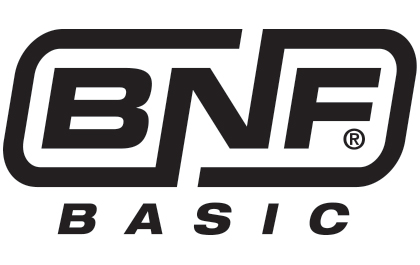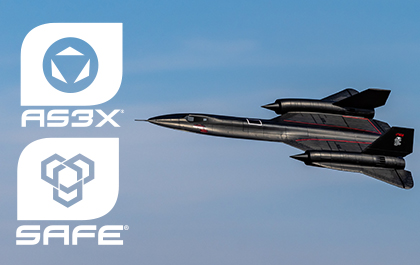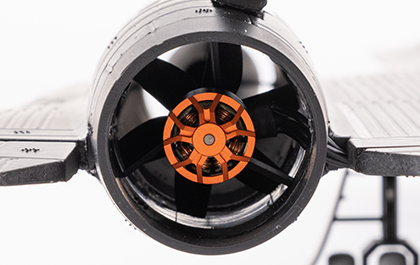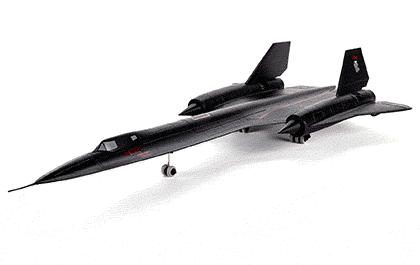SR-71 Blackbird 40mm Twin EDF BNF Basic
SR-71 Blackbird 40mm Twin EDF BNF Basic
ORDER ONLINE, PICK UP IN-STORE SPECIAL!
In The Box
- (1) E-flite® SR-71 Blackbird Twin 40mm EDF
- (4) Spektrum Linear Servos (installed)
- (2) Spektrum Brushless Outrunner Motors (installed)
- (1) Spektrum Control Unit with (1) Receiver and (2) Brushless ESCs (installed)
- (1) SR-71 Blackbird Twin 40mm EDF BNF Basic Product Manual
Needed to Complete
- (1) Full-range 5+ Channel Spektrum™ DSMX®/DSM2® Compatible Transmitter
- (1) 4S 14.8V 2200mAh 30+C LiPo with EC3™ or IC3® Connector
- (1) Compatible LiPo Charger

- An officially-licensed* replica of the world’s fastest and highest-flying manned aircraft that offers a flying experience unlike any other model
- Twin 40mm fans and outrunner motors compatible with popular 4S 2200mAh 30+C batteries
- Easier to fly with innovative and optional-use SAFE® Select flight envelope protection
- Includes an extra set of optional-use, red-painted vertical stabilizers that snap into place for improved visibility
- Almost completely factory-assembled and ready to fly right out of the box
Features
- An officially-licensed* replica of the world’s fastest and highest-flying manned aircraft that offers a flying experience unlike any other model
- The most affordable, practical and easiest to fly SR-71 EDF (Electric Ducted Fan) jet model yet
- Twin 40mm fans and outrunner motors compatible with popular 4S 2200mAh 30+C batteries
- Real-time overall battery voltage, current and other telemetry data via compatible transmitters
- Spektrum™ receiver with fly-by range telemetry and industry-leading 2.4GHz DSMX® technology
- Easier to fly with innovative and optional-use SAFE® Select flight envelope protection
- The unmatched stability and locked-in feel of exclusive AS3X® technology
- Four factory-installed servos for separate aileron, elevator and nose gear steering control
- Take off from and land on smooth surfaces using the included landing gear plus steerable nose wheel
- Remove the landing gear and utilize the molded-in finger grips plus automatic Hand Launch Assist Mode when flying over grass or other suitable surfaces
- Fully-molded and extremely durable EPO airframe with plastic and composite reinforcements throughout
- Includes an extra set of optional-use, red-painted vertical fins that snap into place for improved visibility
- Almost completely factory-assembled and ready to fly right out of the box
- Factory-applied, fully-painted finish with optional-use “Habu” decal

Skill Level 3 – Experience Required
Skill Level 3 aircraft, like this one, are suitable for more experienced RC pilots who already have the skills to assemble, set up and fly similar class models. And although this is the easiest to fly SR-71 model yet, it’s not a suitable first-ever RC aircraft for new pilots or first-ever EDF (Electric Ducted Fan)/jet model for intermediate to experienced RC pilots. You should have the experience and skills necessary to successfully fly high-performance EDF models like the E-flite Habu SS (Super Sport) 50mm or 70mm, the Viper 70mm and/or larger EDF models before attempting to fly the SR-71 Blackbird Twin 40mm EDF.
Are you new to flying RC (Radio Controlled) aircraft? If you are, the SR-71 is not a suitable first-ever RC model and we recommend learning to fly with one of our purpose-built trainer aircraft such as the E-flite® Habu STS (Smart Trainer with SAFE) 70mm EDF. It's equipped with exclusive and innovative SAFE technology that makes it possible for almost anyone to learn to fly successfully! The Ready-To-Fly (RTF) Basic version includes almost everything needed to fly (except for a compatible LiPo battery and charger that are sold separately) and is a perfect choice if you're a new RC pilot!

Bind-N-Fly Completion Level Advantage
Already own a Spektrum™ transmitter? Bind-N-Fly (BNF) aircraft make getting into the air quickly and with the best control experience possible easier than ever. They come out of the box with the power system, servos and a Spektrum 2.4GHz receiver installed so all you need to do is bind the receiver to a compatible transmitter, finish any final assembly, and fly!

Exclusive Technologies
This is the first SR-71 Blackbird model equipped with exclusive Spektrum™ AS3X® and SAFE® Select technologies. AS3X works behind the scenes to smooth out the effects of wind and turbulence to deliver a locked-in feel that makes it seem like you're flying a much larger airplane. Optional-use SAFE Select offers pitch and bank angle limits along with automatic self-leveling that can be turned on and off at the flip of a switch to make this an easier to fly Blackbird.

Telemetry Capability
The SR-71 Blackbird Twin 40mm EDF is equipped with a control unit including a receiver and ESCs that provide a variety of real-time power system-related telemetry data including overall battery voltage, current draw, and more – when using Smart and non-Smart batteries – to compatible Spektrum AirWare™ equipped transmitters (including the DX6e and 8e, DX6 G2/3 and 8 G2, the DX9, NX6, 8 and 10, iX12, iX14, iX20 and others) while you fly.

High Power EDFs
The factory-installed brushless power systems feature 40mm fans with high-RPM outrunner motors. This twin power system setup is designed to deliver an excellent blend of performance and flight time with popular 4S 2200mAh 30C+ batteries.

Gear Options
You can install the included fixed landing gear with a steerable nose wheel – featuring tires that replicate the look of the unique aluminum-infused tires used on the full-scale aircraft – to taxi, take off and land on smooth surfaces. Or you can leave the landing gear off for more speed and vertical performance plus easy hand launches over and landings on grass while utilizing the molded-in finger grips and automatic Hand Launch Assist Mode.

Durable Design
The EPO airframe features molded-in panel lines and other scale surface details, along with plastic-reinforced fuselage chines plus composite reinforcements in the nose and throughout, to make it extremely durable yet also lightweight. The result is an outstanding scale appearance that's easy to maintain and delivers the best possible flying experience.

Factory Assembled
The SR-71 Blackbird Twin 40mm EDF arrives nearly 100% factory-assembled and ready to fly right out of the box! The only assembly that’s required is to snap the black vertical fins – or the additional set of red painted fins that offer improved visibility – into place. Then program and bind your 5+ channel Spektrum™ DSMX®/DSM2® equipped transmitter to the factory-installed receiver and you can be flying within minutes of taking it out of the box!

Factory Finished
The factory-applied and fully-painted plus decal finish not only looks great but also replicates the “Habu” markings of 17958, including an optional-use decal for the nose.























